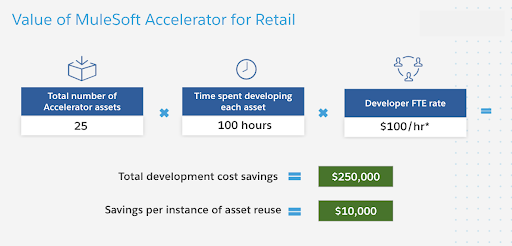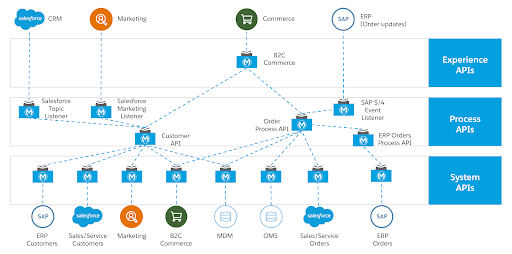COVID-19 dramatically changed the way people shop and purchase consumer goods. It seems like every article about the retail industry since the start of the pandemic has talked about how the lockdowns have changed customer’s preferences for companies that provide online shopping with curbside pickup or delivery.
According to BigCommerce, the companies that already had this omnichannel presence in place saw sales skyrocket, while the other had to rapidly adopt some way of providing a similar service to remain in business. The main platform as a service and infrastructure as a service (PaaS/IaaS) providers (AWS, Azure, and GCP) quickly came in and offered fast on-boarding and services to help these companies catch up in the omnichannel race.
PaaS/IaaS solve the platform and infrastructure issues, but how are retailers supposed to connect these omnichannel digital solutions with their existing systems? This blog will explore this very challenge and show how iPaaS can be a solution.
Comparing iPaaS to PaaS/IaaS
Let’s start with what PaaS and IaaS provide:
- Containers for microservices
- Requires you to code the integrations yourself
- Serverless functions
- Requires you to code the integrations yourself
- API management
- Used as a proxy and there are no built-in integration
- App-to-app or container-to-container flows
- Requires you to code the integrations yourself
- Monitoring
- Most solutions provide decent monitoring
PaaS/IaaS offers a platform for the IT team to code all the connections and integrations themselves. However, without the supportive features, this almost alway ends up as coded point-to-point integration. And as your connections grow, this quickly becomes unwieldy, expensive, and will not be agile.
Now let’s look at what iPaaS offers to reduce or eliminate code, and prevent the point-to-point risks:
- Out-of-the-box connections to most of today’s major systems.
- Pre-built integration templates to connect the most common application.
- Graphically-oriented drag-and-drop processes and data mappings for quick and easy development.
- Built-in expressions and scripts designed and optimized for data mapping.
- Easy security and service level agreement policies to all web APIs and services.
- Unified monitoring and alerting of connections and processes.
- Real-time graphic visualization of running iPaaS integrations, connections, web APIs, and services.
- Automated web API and service discovery and reuse to prevent the duplication of effort and computing inherent in point-to-point integrations.
As shown above, iPaaS is specifically designed for connecting and integrating applications, services, and systems. The choice boils down to buy vs build. With an iPaaS solution you are buying all the features you need for integration and creating reusable services. With PaaS/IaaS you have to build most of it yourself.
How much will an iPaaS solution cost?
The current environment requires retailers to act fast and at the lowest total cost of ownership (TCO). According to MuleSoft, combining Anypoint Platform and its accelerator template for retail, saved a quarter of a million dollars in TCO compared to building it in PaaS.

On paper the PaaS price tag seems less expensive, but when the development costs are added in this is the more expensive solution.
Reusing existing code and services takes less time and costs less than developing more or less the same code and connections again and again. For decades, the concept of avoiding point-to-point integration and service reuse has been around. However, the tools and technologies were too cumbersome and disjointed for most companies to implement and they still ended up with siloed systems and messy connections.
iPaaS was created to easily solve this point-to-point mess in conjunction with reusable web APIs. One of the most widely used concepts to facilitate reuse is API-led design. Using iPaaS with API-led design, will bring huge cost savings. According to MuleSoft’s research, a company using iPaaS and following the API-led approach can save $3M in their first three years.
PaaS/IaaS have nothing to facilitate reuse, and integration done on these types of platforms almost always devolve into point-to-point and cost more in the long run.
The agility of service reuse
The great thing about API-led design is the existing services and integration are available for reuse. The diagram below shows the API-led concept:

To implement a new process like curbside pickup, the System APIs and other Process APIs can be reused to quickly develop the new curbside process and user/employee experience APIs. Without this reuse, these services and integrations would be duplicated, slowing the development effort. Since these services are discoverable (with their location, schemas, documentation, security requirements, and service layer agreement), developers can test out an auto-generated mock-up of the API and request access for their programs to use the API/service.
Large amounts of reuse poses two fundamental issues. One, is security, and the other is overuse. A good iPaaS can solve both. The API owners can set the security and usage (SLA) requirement of their API/services, either generally or individually. An API manager can apply these policies to APIs/services to protect the process and backend systems. In addition, the policies can change without touching the underlying API/service. Altogether, this seamless feature experience allows easy reuse and the agility and savings that follow.
How retailers can leverage iPaaS and reuse
The previous two sections described the benefits of iPaaS and reuse in a generic fashion, and set the stage for us to understand the true advantage of iPaaS vs the PaaS/IaaS providers. In this section, we showcase integration solutions designed for the retail industry.
There are several well designed iPaaS solutions geared towards retail. Such as MuleSoft’s API-led templates for omnichannel and Accelerator for Retail. When evaluating which iPaaS solution fits the needs of your business, make sure it is designed with modular components and has a reusable API-led design, like the one shown below. The solution should also make full use of security and scalability.

When modularity, security, scalability, and reuse are combined together in one package it provides significant development cost savings and sets the retailer up for even greater savings and agility in the future.
Summary
In summary, PaaS/IaaS has revolutionized the way IT departments develop and deploy applications and help retail companies onboard solutions quickly. However, the question regarding how to integrate applications comes down to: buy it with iPaaS, or build it with PaaS/IaaS.
Learn how to unlock the full potential of iPaaS with API management by downloading our eBook.









